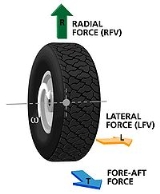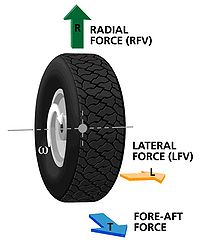
Lateral Force Variation
Encyclopedia
Tires provide for steering, traction, braking, and load support by transmitting forces between the vehicle and the road. Lateral Force Variation (LFV) is a property of a tire that characterizes its dynamic behavior of these forces. High values of LFV for a given tire reflect a high level of manufacturing variations in the tire structure that will impart ride disturbances into the vehicle in the lateral, or steering, direction. LFV is measured according to processes specified by the ASTM International
in ASTM F1806 – Standard Practice for Tire Testing.
 LFV can best be explained by example. Assume a perfectly uniform tire mounted on a perfectly round wheel loaded with a constant force
LFV can best be explained by example. Assume a perfectly uniform tire mounted on a perfectly round wheel loaded with a constant force
against a perfectly round test wheel. As the wheel turns, it turns the tire, and the tire carcass undergoes repeated deformation and recovery as it enters and exits the contact area. If we measure the lateral force between the tire and the wheel we will see zero change as the tire turns. If we now test a typical production tire we will see the lateral force vary as the tire turns.
Consider a good tire with LFV of 4 pounds. This tire will induce a 4 pound force sideways into the vehicle every rotation. The frequency of the force will increase in direct proportion to rotating speed. This affect will influence the steering of the vehicle. Tire makers test tires at the point of manufacture to verify that the RFV is within allowable quality limits. Tires that exceed these limits may be scrapped or sold to markets that do not require stringent quality.
ASTM International
ASTM International, known until 2001 as the American Society for Testing and Materials , is an international standards organization that develops and publishes voluntary consensus technical standards for a wide range of materials, products, systems, and services...
in ASTM F1806 – Standard Practice for Tire Testing.

Force
In physics, a force is any influence that causes an object to undergo a change in speed, a change in direction, or a change in shape. In other words, a force is that which can cause an object with mass to change its velocity , i.e., to accelerate, or which can cause a flexible object to deform...
against a perfectly round test wheel. As the wheel turns, it turns the tire, and the tire carcass undergoes repeated deformation and recovery as it enters and exits the contact area. If we measure the lateral force between the tire and the wheel we will see zero change as the tire turns. If we now test a typical production tire we will see the lateral force vary as the tire turns.
Consider a good tire with LFV of 4 pounds. This tire will induce a 4 pound force sideways into the vehicle every rotation. The frequency of the force will increase in direct proportion to rotating speed. This affect will influence the steering of the vehicle. Tire makers test tires at the point of manufacture to verify that the RFV is within allowable quality limits. Tires that exceed these limits may be scrapped or sold to markets that do not require stringent quality.

